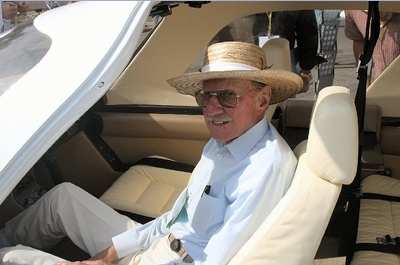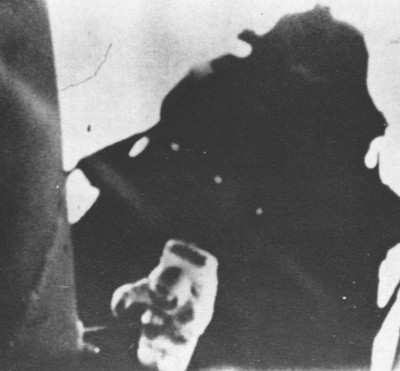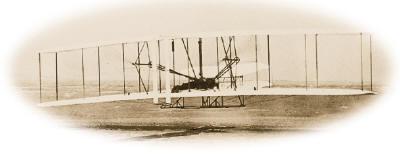You'll Be Amazed At What You Hear
By Aleta Vinas
What did you miss last year at Oshkosh? How about listening to
history and then a mere 11 months later seeing it happen? Last
year, innovative aviation designer Burt Rutan spoke about his
coveted SpaceShipOne, the leading project to be the first private
re-usable manned craft able to successfully achieve sub-orbital
flight. Rutan says modestly, "If people can see that a little shop
in the desert, using zero help from NASA, can do it, then they'll
know they can do it too." Rutan seems fairly appalled that "no one
cares that we (regular people) want to go to the moon and have the
ride of a lifetime." Rutan plans to change that and have an
"enormous impact on our ability to fly in space" once SpaceShipOne
is completed. Sign me up for a window seat, please!

Wanna sit and hangar fly with Bob Hoover? Okay, so we were
asking the questions and listening with rapt attention. Here's a
sample, a friend of Hoover's bought a Stearman. He asked Bob to ask
the new female flight instructor to teach him to fly, saying he
knew a "little bit" about the plane. Hoover acted like the
quintessential lousy pilot, bouncing landings and the like. Finally
he said to the, no doubt exasperated, CFI, "let me show you
something." And proceeded through an aerobatic routine. Admittedly
Hoover "felt bad" about the incident. On being a test pilot, Hoover
quips "It's not as exciting as you think it is, it's many hours of
boredom and a few seconds of stark terror."

Retired pilot, instructor and examiner in the SR-71, (1971
– 1984) Colonel Richard Graham (USAF) took us through a
typical Mach 3+ mission from wake up to debrief. The missions start
around 0500 with breakfast, a healthy steak and eggs meal back when
he was active. After breakfast, it's off to mission briefing, a
quick physical, suit up and take off at 0800. The SR-71 pilot and
his RSO (Reconnaissance Systems Officer) train as a team from the
beginning. If one is unable to fly the mission, both are "grounded"
and the back-up crew will fly. The first refueling is done shortly
after take off. A typical mission will last four to five hours. At
his booth where he was selling his books, SR-71 Revealed and SR-71
Blackbird: Stories, Tales and Legends, Colonel Graham talked about
the "Rocket Ride". Fifty-seven minutes from take off to touchdown;
out from Okinawa over the Korean DMZ, a left turn and back down
into Okinawa. Busy is an understatement.
 Another SR-71 pilot Terry Pappas,
who flew the Blackbird from 1985 – 1990, recounted one long,
special mission in 1987. Pappas and his RSO were next in line for a
mission. "Violating the mission ladder was sacrilegious" and so the
mission requested by the President and command councils fell to
Pappas and his teammate.
Another SR-71 pilot Terry Pappas,
who flew the Blackbird from 1985 – 1990, recounted one long,
special mission in 1987. Pappas and his RSO were next in line for a
mission. "Violating the mission ladder was sacrilegious" and so the
mission requested by the President and command councils fell to
Pappas and his teammate.
They were to find out "what was going on with Iran and Iraq." It
was to be a nine-hour mission with five refuelings. Some poor
weather over the South China Sea on both the inbound and outbound
legs gave Pappas some interesting moments. The 100-knot tailwind at
altitude, along the "black line" (their flight path for the
mission) also caused some problems. Already at max bank and minimum
afterburner in their turn towards home, Pappas relied on a "trick"
he heard previously but had never tried in the aircraft. He took
the plane off auto and "down trimmed the EGT on the engine
approximately fifteen degrees" this slowed the aircraft enough for
a safe turn. By the end of the mission, Pappas, himself, was
"running on fumes." Taxiing in with the recorded information,
Pappas estimated about two hundred people in the hangar who erupted
in applause as they stepped out of the Blackbird. Pappas sums up
the SR-71 "feeling" as "the kind of spirit this plane
engenders in people, is truly remarkable. Not just the pilots, but
all the crew."
 Dr. Peggy Chabrian, President of
Women in Aviation International spoke about opportunities for women
in aviation. Women make up a fairly constant 6% of the aviation
force. She sees the areas for growth potential in maintenance and
avionics, not just for women but men as well. For those who are
still in high school and want to pursue a career in aviation there
are over four hundred, two and four year colleges in the US with
aviation programs. Additionally many scholarships are available for
women of all ages.
Dr. Peggy Chabrian, President of
Women in Aviation International spoke about opportunities for women
in aviation. Women make up a fairly constant 6% of the aviation
force. She sees the areas for growth potential in maintenance and
avionics, not just for women but men as well. For those who are
still in high school and want to pursue a career in aviation there
are over four hundred, two and four year colleges in the US with
aviation programs. Additionally many scholarships are available for
women of all ages.
How about a history lesson from Neil Armstrong? Jim Slade,
former ABC broadcaster, introduced Space Shuttle astronauts Jim
Voss and Charlie Precourt first. Neil Armstrong was introduced, to
a thunderous standing ovation. First on the agenda was a bit of
history making for all of us, it was going to be the farthest
long-distance call any of us had ever been on (with the exception
of the men on stage). A call was placed to Dr. Ed Lu at the
International Space Station. Dr. Lu was expecting the call but was
pleasantly surprised at the addition of Armstrong. The crowd belted
out a hello to Dr. Lu at the request of the astronauts on stage.
When asked about not being able to make Oshkosh, Dr. Lu offered
"this is the first time in seven years I've missed Oshkosh."
Sometimes there is a REALLY good reason to miss EAA AirVenture.
What's your excuse?

Once the call was over, our history lesson started. Neil gave a
short synopsis of Wilbur and Orville Wright up to the time they
began to work on solving the problem of flight. From that point,
Armstrong gave a detailed account of the Wright's research,
including several direct quotes from letters and documents the
Wright Brothers had written. The Brothers wrote Octave Chanute and
the weather bureau for help in finding a location with lots of room
and steady wind, that was how Kitty Hawk, North Carolina became
part of history. The Wrights had to design and build their own
engine when inquiries to the current manufacturers provided no
suitable motor. Each test season allowed their engine to be revised
and improved. Needless to say, they also needed to design and build
their own propeller, marine props would not do the trick in the
air. Each succeeding season yielded a better and better aircraft.
Then on Dec 17, 1903, history was made in 12 seconds and 120 feet.
Armstrong continued the story past the events at Kitty Hawk to a
few years later and the thirty minute history lesson was over. I
couldn't help thinking, "if all my history classes had been
presented like this, I'd have paid more attention and received
better grades."

The forum topics at Air Venture are endless, airspace, paper
airplanes, History of the Civil Air Patrol, Fabric 101, Story of
the Tuskeegee Airmen, ELTs as well as Q&A sessions with the
world's most famous aviators and more. It's like hangar flying to
the max multiplied by a googolplex. Check out the extensive list
this year!
 ANN's Daily Aero-Linx (04.15.24)
ANN's Daily Aero-Linx (04.15.24) Classic Aero-TV: 'No Other Options' -- The Israeli Air Force's Danny Shapira
Classic Aero-TV: 'No Other Options' -- The Israeli Air Force's Danny Shapira Aero-News: Quote of the Day (04.15.24)
Aero-News: Quote of the Day (04.15.24) Airborne 04.16.24: RV Update, Affordable Flying Expo, Diamond Lil
Airborne 04.16.24: RV Update, Affordable Flying Expo, Diamond Lil ANN's Daily Aero-Term (04.16.24): Chart Supplement US
ANN's Daily Aero-Term (04.16.24): Chart Supplement US








